DIY cast iron bathtub installation: a detailed step-by-step guide
So that the installation of a cast-iron bath does not seem an overwhelming and very difficult stage of repair, it is necessary to study the process itself. We examined it in detail in our article, highlighting the main stages of installation and paying special attention to each step.
Acquainted with the nuances of the installation, it is quite possible to cope with such work on their own. The main thing is to do everything correctly and consistently, following the installation recommendations.
It is important to avoid common mistakes, some of which we also examined in our article. This will save a lot of money on the services of relevant specialists.
The content of the article:
What to look for when buying a bath?
Choosing a cast-iron bathtub is quite difficult - so many beautiful models are offered by manufacturers that you won’t immediately understand which one to take.
There are original designer baths with beautiful legs, and there are regular ones, there are angular, round, simple rectangular shapes, with a hydromassage function and musical accompaniment to the bathing process - for any consumer.
It is important not to get lost in all this diversity and study the technical characteristics. Consider the main criteria that are important when choosing a bathtub made of cast iron.
Declared and actual dimensions of the product
The very first and most important thing is to choose the optimal size of plumbing equipment, based on the individual parameters of your room.
The choice of cast-iron bathtubs on the market is very diverse. It is important to consider not only your wishes, but also the actual size of the room, floor, and the strength of the floors of the building.
Do not forget about the size of the doorways, the presence and size of the freight elevator in the house, the width of the flights of stairs so that the purchased bath can be physically delivered to the installation site.
Weight bath with optional equipment
Product weight is important. If this is an old-built house with wooden floors, the installation of a large cast-iron bathtub with a hydromassage can end very poorly - at one fine moment the partitions will not stand up and everything will collapse to the neighbors below.
Well, if no one is hurt in this fall. Therefore, it is important to take a reasonable approach to choosing the model to be installed.
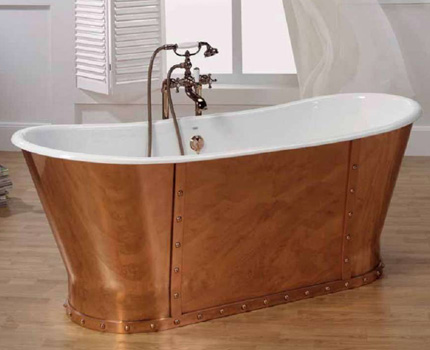
For a private house and apartments with strong floors, there will be more options - both domestic and foreign manufacturers. The form of products, a variety of additional functions and capabilities, overall dimensions - choose what your heart desires.
The owner of a small apartment with a combined bathroom has significantly fewer models - the main thing is that the equipment enters the room.
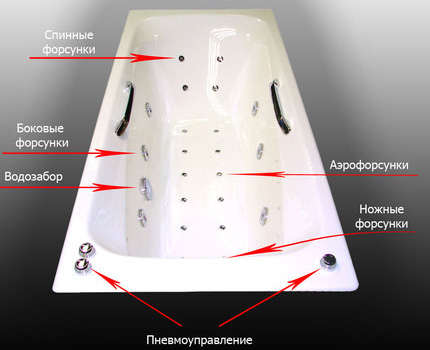
Enamel Thickness and Quality
Another important characteristic is the quality of the enamel that covers the work surface. By standards, its thickness should be at least 1 mm along the walls and at least 1.5 mm at the bottom of the bathtub.
As practice shows, cast-iron bathtubs of foreign manufacturers significantly benefit by this indicator. Their coating is more durable and durable.

Also, it is foreign technology that allows the production of more durable and lighter bathtubs made of cast iron. The main advantage of domestic products is low cost.
For a budget repair, this option will be more acceptable, and a service life of up to 100 years is a nice bonus. Only you need to properly and timely care for the cast-iron bath so that it retains its attractiveness.
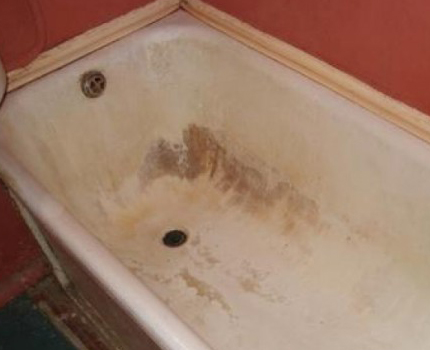
Complete set and accompanying documentation
Choosing your perfect bath, do not be shy to be interested in the seller's accompanying documentation. Manufacturers usually provide installation, use, and care instructions.
Also, in the kit with the product most often there are legs on which to install a cast-iron bath, mounts for their connection, drain valves and an equalizer of electric potentials.
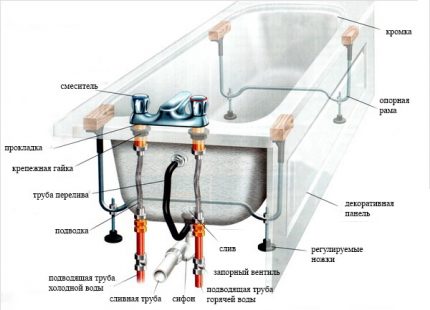
First you need to carefully inspect the bath for chips, cracks and scratches. If everything is in order, then all the components will have to be carefully checked so that they are suitable for use. Sometimes, in the kit some details are missing - they will have to be bought separately.
Particular attention should be paid to the supports (legs) of the bath. They must support the weight of the product that comes with it. If the legs are flimsy and unreliable - it is better to refuse such a bath. After all, a conscientious manufacturer will not save on supports.
We also have a detailed guide to cast iron bathwhich we recommend that you familiarize yourself.
Step-by-step installation process
Having made the decision to install a cast-iron bathtub without involving specialists, you have to do everything yourself. It is useful to first deal with the theory of installation in detail so that it is easier and more comfortable to work with.
To bring a bath to the desired floor and deliver to the room without damage, you can hire movers. But this option will clearly fly into a pretty penny. It is better to invite someone from your friends, taking care of one or two assistants - you yourself can not cope with the weight of the cast iron product.
Stage # 1 - leveling the bathroom floor
Before proceeding with the installation of a cast-iron bath, it is necessary to finish the preparatory work in the appropriate room as much as possible. This will help protect the product from accidental damage and chips during repair.
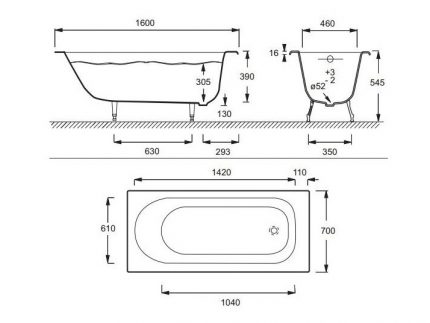
Depending on the shape of the product, its future installation location and the overall design of the room, it is recommended to align the walls and floor. If it is assumed that there is a tile in the room, then it is laid before installing the bath. Sometimes tiles are laid to the level of the bath.
This allows you to firmly recess the edges of the product into adjacent walls, which guarantees greater stability.When the walls and floor are tiled in the right places, you can proceed with the installation of plumbing equipment.
Stage # 2 - connecting accessories
Everything must be done very carefully so as not to scratch either the tile or the top layer of the bath enamel. You can use a soft cloth so that during the connection of accessories and turning the product from one side to the other, do not accidentally beat off the edges.
The first step is to carefully turn the cast-iron bath to the side so that it is convenient to connect the siphon and other parts to drain the water.
To do this, you have to take the package with accessories that comes with the plumbing capacity. If this is not available, then you need to buy a siphon at the plumbing store in advance to connect the bath to the sewer system.
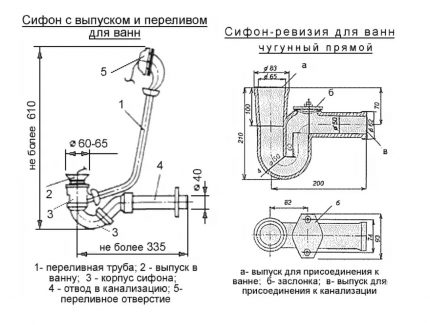
First you need to collect a siphon, attached to the hole in the bottom of the bath.
It is going to be quite simple, the main thing is to correctly install the rubber gaskets and put seals before tightening the nuts:
- the collected siphon is attached to the bottom hole located at the bottom of the bathtub and designed to drain the water;
- a rubber pad corresponding to the size is placed;
- then a siphon is screwed in from the outside, and a siphon mesh from the inside.
Next, you have to collect the upper overflow - a hole that prevents overfilling of the tank with water is on the wall of the bath. It serves to drain excess water. To assemble it correctly, you need to connect the corresponding part - a branch for overflow.
Attach the corresponding overflow part to the side hole, having previously placed the seal between it and the product wall. The drain is expanded on the water intake side.
This part is fixed to the inside of the bath with a special bolt passing through the overflow hole. It simultaneously attaches a lid with water holes to the inside of the bathtub.
It remains to connect this overflow to the main siphon. This can be done using a special pipe that comes with the kit. The pipe may be corrugated, made of plastic, or of another type.
The outlet of the upper overflow with a special nut is attached to the pipe, which is then connected to the siphon. Be sure to put an elastic band under the nut - the sealant included in the kit.
This will protect in the future from leaks. Also, on the other side of the siphon there is a hole to which you have to screw the pipe - the outlet pipe - to enter the sewer pipe.
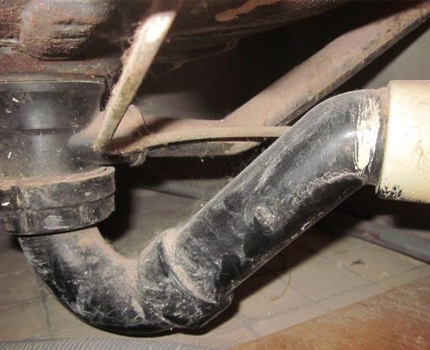
The issue with the difference in the diameters of the siphon and the sewer pipe can be successfully solved by a special cuff. She is conical. It is lubricated with sealing grease, put on a siphon pipe, the diameter of which is usually 40 mm, and inserted into the socket of a sewer pipe with a diameter of 50 mm.
Such a connection usually does not leak, but if a leak suddenly appears, fill the assembly with sanitary sealant.
The material for the manufacture of a siphon and overflow for a bath can be plastic, aluminum alloy or brass. Regardless of the type of material, it is important to carefully interconnect the components, using gaskets and seals, and not overtighten the nuts so that nothing is cracked.
The floor siphon for a bathtub happens with audit and without. The first is much more convenient, because in case of clogging, you can unscrew the lid of the revision and clean everything.
As for the size, the siphon is usually not high. It is convenient to install it under the bottom, if the basic installation rule is not violated - the distance from the bottom of the tank to the floor should be at least 145 mm.
In our other article, we made recommendations for choosing the best siphon design and step-by-step instruction on assembly and installation of a siphon to the bath.
If the design of the bath involves the installation of a mixer, then now is the time for its installation. Then using flexible hosesconnect to water outlets.
Do not forget about statistical electricity that can harm a person. It arises from the impact of a jet of water on the edge of the bath. To prevent electric shock, it is necessary to install an electric potential equalizer - this is a metal wire or plate that comes with the kit.
If such a part is not available, you can use ordinary steel wire with a diameter of at least 5 mm. One end connects to the second overflow, and the second must be connected to a water pipe or ground.
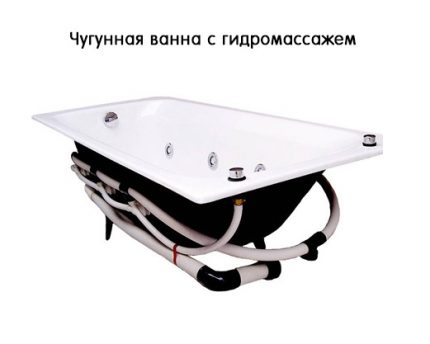
It is important that when the bath is grounded, all joints are thoroughly cleaned to a shine and then insulated. To do this, you can use window putty or tape.
In more detail, the process of grounding the bath we examined in another article.
Stage # 3 - foot assembly and bath alignment
The second stage in the independent installation of the bath is screwing the legs. Their height in most cast-iron models is adjustable.
The main thing is to maintain the generally accepted norm:
- the distance from the upper edge of the bath to the floor should be at least 60 cm, more detailed standards and norms of the height of the bath to the floor reviewed here;
- not less than 50 cm, if this capacity will be used by a child in kindergarten or disabled;
- the height during installation of the bath may exceed the norm, but be less - in no case.
It is convenient to fasten legs while the bathtub is in a lying position. By carefully screwing them with the special bolts and nuts that come with the kit to the mounts, you can turn the product over.
Before this, you should consider what coating it will be on. If there is a danger of scratching the tile with legs, then they can be wrapped in special plastic linings.
Sometimes in houses with weak ceilings, the legs of a cast-iron bathtub are placed on wooden boards, which makes it possible to evenly distribute the load across the entire floor area. This option is not suitable for rooms where, according to the designer, it is planned to place a bathtub with open legs, without using screens.

The bath with screwed supports is turned over and mounted on legs. Particular attention is paid to the stability of the structure. Using the building level, it is necessary to achieve a horizontal arrangement of the upper edges of the tank.
Also, do not forget about a slight bias towards the drain hole. According to the norms, its size is 2 cm per 1 meter of product length.
It remains to firmly fix the bath at its permanent location. But, before such a crucial step, you must definitely check whether the connections are leaking and all the water is completely gone.
To do this, put paper or a white dry cloth under the bathtub, let in water and watch the result. If there is the slightest leak somewhere, then on paper it will be well noticeable.
In addition to the factory legs, which are supplied or purchased separately, a situation may arise when you need to fix the bath using a solid support. In such cases, brickwork is used. To figure out how to properly install the bowl on the bricks, go this link.
Stage # 4 - installing the bowl and sealing joints
When all the components are installed, the units are tight, and the legs hold the bathtub in a horizontal position, you can proceed to the final stage - installing the tank and sealing all the joints and seams.This is true for models that will stand close to the walls.
For free-standing bathtubs with open legs, it is enough to firmly fix the supports with waterproof polymer glue so that the filled tank does not leave anywhere with its owner during the washing process.
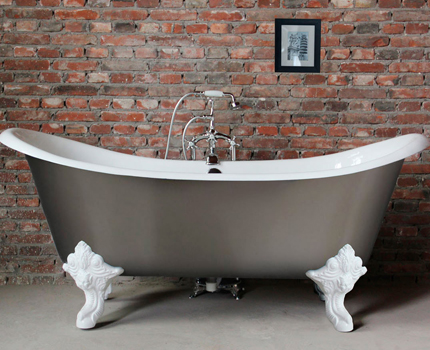
If the tile is laid to the level of the bath, then a recess is made in the wall - a gutter, where the edge of the container starts. It is important that the side does not go deep into the wall, otherwise it will become an uncomfortable moment during operation and will spoil the look.
Also, do not forget to immediately remove all unnecessary, carefully wiping the surface of the bath. It is advisable to provide full protection of the enamel of the sanitary equipment, wrapping the surface with a film.
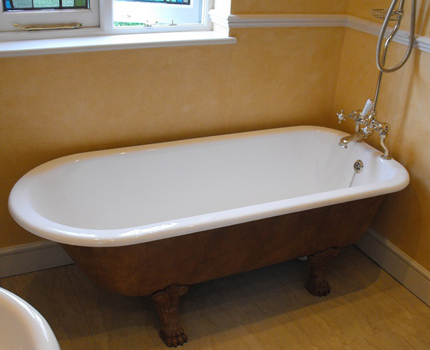
All joints and small gaps are treated with cement or polyurethane foam, coated with silicone sealant on top.
Sometimes they use a special plastic corner for decoration. It glues easily and looks good, but quickly loses its attractiveness and begins to pass water. It is more practical to make a tight fit of the tile on top and use a grout.
We have a material on the site in which the best joint sealing methods between the bathroom and the wall. We recommend that you familiarize yourself with them.
Having processed all the joints, you can proceed to setting screens and tiling. At this stage, it is important to provide free access to the siphon revision. Indeed, no one is safe from clogging of pipes or leaking.
For such situations, a freely removable door or cover disguised as a tile is provided. Or they put a separate tile on 4 magnets - as you like more. The rules for choosing and installing the inspection hatch we reviewed in this article.
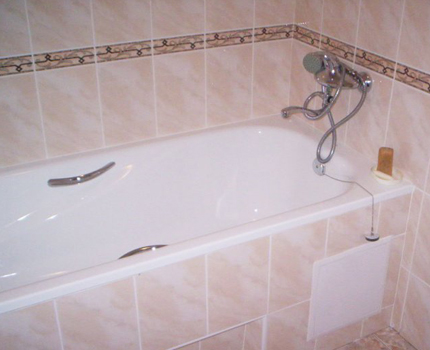
Errors during installation
Often, even a hired cast-iron bath installation team does a poor job. The most unpleasant thing is that all errors become noticeable only during operation.
At first glance it seems that everything was done correctly, but in fact it turns out that the opposite is true. You should pay attention to the most common mistakes made by home masters who first encountered self-installation.
Firstly, there is no horizontal alignment of the bath using the building level. This can lead to poor or slow water flow, or to an unstable position of the tank. This error must be corrected immediately - after all, the installed equipment is not suitable for use.
Secondly, when mounting the legs, screws can be tightened. Cracks or chips may appear as a result. This seemingly inconspicuous nuisance in the near future will lead to the need to replace the bathtub with a new one.
If, through negligence during the installation process, you hit the bowl and chips or scratches appeared on its inner surface, you can perform a series of work on enamel recovery.
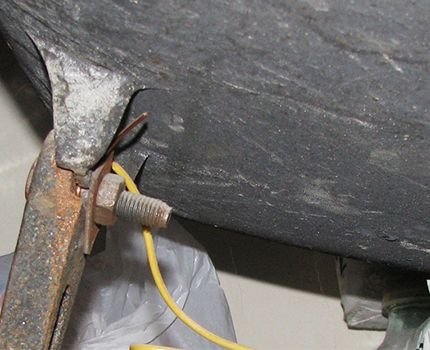
Thirdly, it is extremely undesirable to put thick rubber linings under the legs. Indeed, in the process of bathing, the bath will spring up and after a couple of months the sides will move away from the walls of the room. Water will begin to fall into these gaps, flowing under the bathtub.It is necessary to spend time, effort and money to resolve this problem.
Fourth, a rather dangerous mistake is not to ground the bath. When installing the equalizer of electric potentials, special attention must be paid to its tight fit to ensure reliable contact.
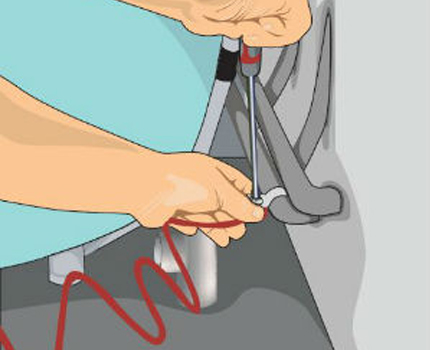
Fifth, when a siphon without revision was used or access to the audit was walled up for reasons of economy. In the event of clogging or breakage, a lot of effort will have to be made to eliminate the problem.
Sixthly, it is very inconvenient when the sides of the bath deeply enter the wall. This visually makes the bathing procedure extremely unpleasant, prevents it from fixing shelves or installing seats. It is important to remember this even at the stage of cutting through the grooves in the wall, so as not to overdo it.
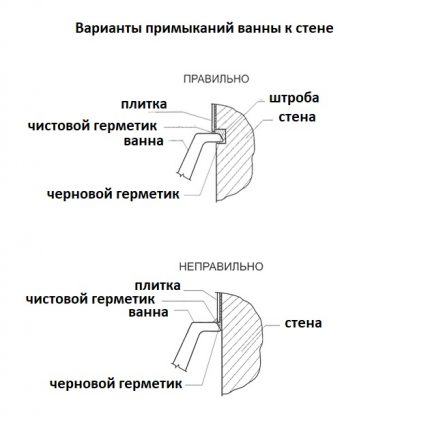
Seventh, do not make a shelf of tiles from the legs. Indeed, during operation, water will fall on it and drain onto the floor. If you make a larger slope of the shelf, then no bottles with shampoos can be put on it - they will slip off.
There are other problems that arise during the installation of the bath, which can ruin the appearance. For example, if you do not wipe the silicone or cement from the surface in time, then it can remain there forever.
Conclusions and useful video on the topic
Video briefing with a detailed demonstration of the bath installation process:
Visual video about the assembly and installation of a polymer siphon:
Benefit on how to independently fix the leakage between the wall and the bathroom:
Having clarified the features and sorted out the main problems that arise in the process, you can independently install a cast-iron bathtub. It will be possible to manage without a brigade, but without assistants - no way. The whole problem is the weight of the product, which one person can not physically cope with..
Do you have experience installing a cast iron bathtub yourself? Tell us how difficult this task was for you.
Perhaps you want to give useful recommendations to home masters who first encountered the question of installing such heavy plumbing? Write advice in the comment block under this article, add a photo of your own installed cast-iron bathtub.

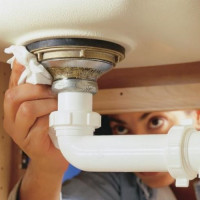 How to install a bath yourself: a step-by-step installation guide
How to install a bath yourself: a step-by-step installation guide 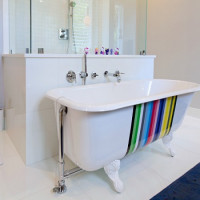 Do-it-yourself cast iron bathtub repair: common damage and repair
Do-it-yourself cast iron bathtub repair: common damage and repair 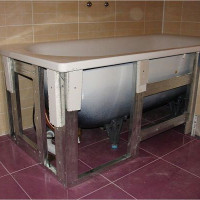 How to install a steel bath with your own hands: step by step instructions
How to install a steel bath with your own hands: step by step instructions 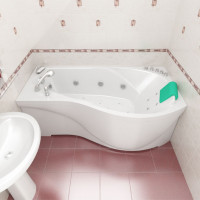 DIY acrylic bathtub installation: detailed step-by-step installation instructions
DIY acrylic bathtub installation: detailed step-by-step installation instructions 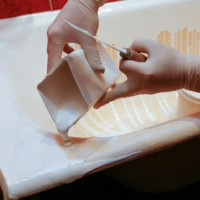 DIY enamel bath: how to treat the bath with liquid acrylic at home
DIY enamel bath: how to treat the bath with liquid acrylic at home 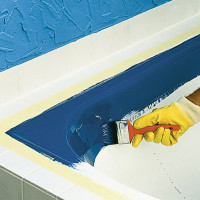 DIY bathtub painting using epoxy enamel and liquid acrylic
DIY bathtub painting using epoxy enamel and liquid acrylic  How much does it cost to connect gas to a private house: the price of organizing gas supply
How much does it cost to connect gas to a private house: the price of organizing gas supply  The best washing machines with dryer: model rating and customer tips
The best washing machines with dryer: model rating and customer tips  What is the color temperature of light and the nuances of choosing the temperature of the lamps to suit your needs
What is the color temperature of light and the nuances of choosing the temperature of the lamps to suit your needs  Replacement of a geyser in an apartment: replacement paperwork + basic norms and requirements
Replacement of a geyser in an apartment: replacement paperwork + basic norms and requirements
After the repair was completed, it was necessary to choose a suitable bath. Cast iron was noticed immediately, because with proper care, its service life is quite long. I wanted to make only some kind of novelty. We decided to take a hydromassage bath. Re-read a large amount of literature, searched for information on the Internet, and prepared for an independent installation. Everything turned out quickly, efficiently. The bathtub looks beautiful. So if you want, you can do everything yourself.
When we did the bathroom repair, we foolishly threw out the old cast-iron bath. Installed cheap acrylic, but it is heaven and earth! I do not like the form, there is no sense of reliability. Again think of cast iron.But I have a question - how to calculate the maximum permissible weight of a bath in an old house? Is there such data somewhere? The old cast-iron bathtub was large, but after reading the article it became somehow scary. Another question on the equalizer of electric potentials - for the first time I hear about this, is it only for bathtubs with hydromassage? For ordinary people, is this not necessary?
Olga, an equalizer of electric potentials - this is such a kind of grounding. What is it for? Any house can have stray currents, for example, if someone grounded it on a pipe or battery, say a washing machine. This can not be done, it is necessary to ground to the shield. But not everyone wants to live honestly, and they do it easier, closer and cheaper. But the equalizer is just what you need so that you are not removed by current when water comes from the tap. It connects precisely to the pipe where the water comes from. If the bath is nullified on the pipe, then correspondingly between the bath and the pipe there will be ZERO volts. But if dishonest groundings appeared in the house, then in the absence of grounding, you can measure up to 30 volts of difference. I personally measured 5 volts. Pleasant not enough. Each time when pouring or when water has already poured into the sewer, then between the mixer you will be plucked by stray currents, especially when draining water from the bathroom. Not only not nice, but m. and dangerous. Those. you must connect the wire to the cast-iron bath bolt to the pipe. It is necessary to make a crimp contact on the pipe like a clamp on a bolt. I don’t remember exactly what it is called, but the point is that the main pipe in the place of future contact must also be degreased with a solvent, then the same crimp contact must be made on it.
And why in Soviet times the bath was not grounded? I have a bathtub without screw / adjustable legs, how can I level it? How can I ground the bath if the riser is made of copper, then there is a section of pipes from the corrugation, then again from copper?
M, who told you that in Soviet times no one grounded the bath ??? Where does such strange information come from?))
Grounding on the bathrooms in Soviet apartments was done, but not always and not everywhere. Moreover, after more than a dozen years, the system could stop working. For an old-style cast-iron bath, grounding must be done as follows:
1. Drill a hole in the foot of the bath;
2. Secure the ground jumper;
3. Stranded wire attached to the foot of the bathroom;
4. Next, the stranded wire is connected to a special distributor.
In turn, wires from other metal objects are also connected to the distributor. Mandatory, the distributor is displayed on a common grounding busbar shield (located in the entrance). And it’s not difficult to level the bath - wooden stands to help.
So how do you propose to lift, turn and generally move a 150 kg cast-iron bath? Jacks, a bunch of friends, some kind of hoist? So much water, and most importantly they didn’t say ...
Ivan, 150 kg where did they get it?))) 1.70 weighed about 119-120 kg. This is in Soviet times. And now even less. As for the jack, heaps of friends, I’ve been laughing for half an hour already, remembering how I, the 18-year-old with her husband, took the bathtub out of the house to the street, changed. So we carried it out carefully, turned it over so that the rain would not pour in, and then they also loaded it into the CAR in a few days, drove the mother-in-law. It was smaller, a little more than a hundred kilograms, but I'm a woman. If you think I'm a bomb carrier, no. I have 45 weight with growth of 1.59. I also recall how the refrigerator Pole dragged 5 km all on the same wheelbarrow (loaded by SAMA), and passed through the pontoon bridge. Yes, now I’m not pulling, but only because of my son’s illness, amid stress, I’m now core and the load is contraindicated ... but 2 healthy people will be able to raise a bath, it’s even funny.